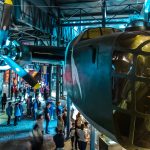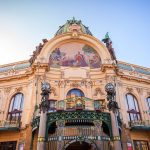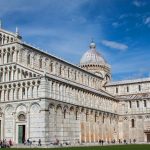
alberta tourist attractions
Alberta is a province in Western Canada. Its landscape encompasses mountains, prairies, desert badlands and vast coniferous forests. It has more than 600 lakes, and rich mineral deposits. In the west, the Canadian Rocky Mountain Parks have glaciers in the Columbia Icefields. The Waterton Glacier International Peace Park is a biosphere reserve that straddles the southern border with the USA.
Alberta is the fourth largest province by area at 661,848 square kilometres (255,541 square miles), and the fourth most populous, being home to 4,262,635 people.Alberta’s capital is Edmonton, while Calgary is its largest city. The two are Alberta’s largest census metropolitan areas. More than half of Albertans live in either Edmonton or Calgary, which contributes to continuing the rivalry between the two cities. English is the official language of the province. In 2016, 76.0% of Albertans were anglophone, 1.8% were francophone and 22.2% were allophone.
Alberta’s economy is based on hydrocarbons, petrochemical industries, livestock and agriculture. The oil and gas industry has been a pillar of Alberta’s economy since 1947, when substantial oil deposits were discovered at Leduc No. 1 well. It has also become a part of the province’s identity. Since Alberta is the province most rich in hydrocarbons, it provides 70% of the oil and natural gas exploited on Canadian soil. In 2018, Alberta’s output was CA$338.2 billion, 15.27% of Canada’s GDP.
1.Banff National Park

Banff National Park is the most visited tourist attraction in Alberta and arguably the most impressive national park in Canada. Just 130 kilometers west of Calgary, the area encompasses spectacular mountain scenery, major ski resorts, beautiful lakes, and the tourist town of Banff.
Wildlife is abundant here, with grizzly bears, black bears, wolves, caribou, and elk, many of which are frequently sighted along the main highway through the park.
Hiking is one of the main summer activities in Banff, and there are many frontcountry and backcountry trails to choose from. Many people explore the park from the comfort of their car, stopping at the numerous roadside lookouts that offer impressive views over the mountains, lakes, and glaciers.
The Canadian Pacific Railway was instrumental in Banff’s early years, building the Banff Springs Hotel and Chateau Lake Louise, and attracting tourists through extensive advertising. In the early 20th century, roads were built in Banff, at times by war internees from World War I, and through Great Depression-era public works projects.Since the 1960s, park accommodations have been open all year, with annual tourism visits to Banff increasing to over 5 million in the 1990s. Millions more pass through the park on the Trans-Canada Highway.As Banff has over three million visitors annually, the health of its ecosystem has been threatened. In the mid-1990s, Parks Canada responded by initiating a two-year study which resulted in management recommendations and new policies that aim to preserve ecological integrity.
Banff National Park has a subarctic climate with three ecoregions, including montane, subalpine, and alpine. The forests are dominated by Lodgepole pine at lower elevations and Engelmann spruce in higher ones below the treeline, above which is primarily rocks and ice. Mammal species such as the grizzly bear, cougar, wolverine, elk, bighorn sheep and moose are found, along with hundreds of bird species. Reptiles and amphibians are also found but only a limited number of species have been recorded. The mountains are formed from sedimentary rocks which were pushed east over newer rock strata, between 80 and 55 million years ago. Over the past few million years, glaciers have at times covered most of the park, but today are found only on the mountain slopes though they include the Columbia Icefield, the largest uninterrupted glacial mass in the Rockies. Erosion from water and ice have carved the mountains into their current shapes.
2.Lake Louise

Lake Louise, the jewel of Banff National Park, is famous for its beautiful turquoise colored water that reflects the surrounding mountains and Victoria Glacier. Located just a short drive north of the town of Banff, the lake is an easy day trip from Calgary.
From the grand Fairmont Chateau Lake Louise is a fabulous view across the lake. A walkway runs along the shoreline allowing visitors a lovely place for a leisurely stroll to absorb the atmosphere. Canoe rentals are also available for those who want to paddle out on the lake.
From the lakeside path, there are excellent hiking trails leading either up the mountain or beyond the lake towards the glacier. One of the most popular hiking trails is the hike up to the Lake Agnes Tea House.
Lake Louise (named Ho-run-num-nay (Lake of the Little Fishes) by the Stoney Nakota First Nations people)is a glacial lake within Banff National Park in Alberta, Canada. It is located 5 km (3.1 mi) west of the Hamlet of Lake Louise and the Trans-Canada Highway (Highway 1).
Lake Louise is named after the Princess Louise Caroline Alberta (1848–1939), the fourth daughter of Queen Victoria and the wife of the Marquess of Lorne, who was the Governor General of Canada from 1878 to 1883.
The turquoise colour of the water comes from rock flour carried into the lake by melt-water from the glaciers that overlook the lake. The lake has a surface of 0.8 km2 (0.31 sq mi) and is drained through the 3 km long Louise Creek into the Bow River.
Fairmont’s Chateau Lake Louise, one of Canada’s grand railway hotels, is located on Lake Louise’s eastern shore. It is a luxury resort hotel built in the early decades of the 20th century by the Canadian Pacific Railway.
Moraine Lake and Lake Agnes are also accessible from Lake Louise.
3. Icefields Parkway and the Columbia Icefield
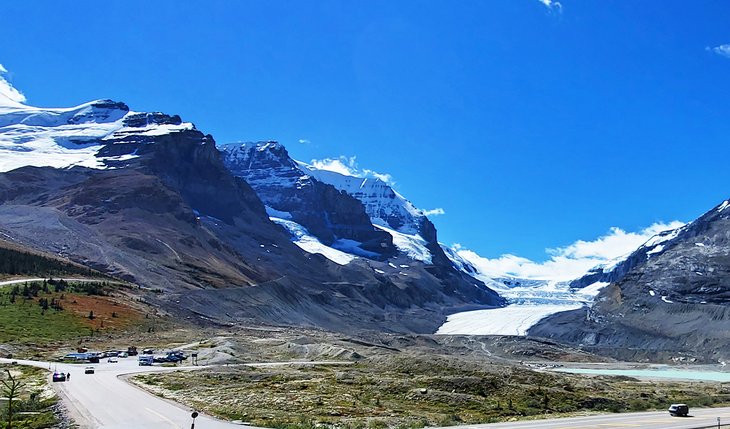
The Icefields Parkway runs from Lake Louise to Jasper and is one of the most beautiful drives in Canada. This 230-kilometer stretch of highway leads past lakes, mountains, glaciers, and waterfalls, with stopping points for visitors to get out and experience the landscape. Numerous hiking trails along the way, most of which are day hikes, lead to scenic lookouts over surrounding glaciers or lakes.
One of the main attractions along the Icefields Parkway is the Icefields Centre. This large visitor’s center features excellent displays on the Columbia Icefields and looks out over the Athabasca Glacier. From the road, it is difficult to comprehend the layout and size of the icefields, but models and photos at the center offer a unique perspective.
De Icefields Parkway (Frans: Promenade des Glaciers), ook Alberta Highway 93, is een weg in Alberta, Canada, die langs veel natuurschoon gaat in de Canadese Rocky Mountains, zoals canyons, gletsjers, en rivieren.
De parkway is 230 kilometer lang en werd voltooid in 1940. Hij loopt parallel aan de Continental Divide, de bergrug die van Alaska, door Canada en de Verenigde Staten naar Mexico loopt. De weg loopt van Jasper (nationaal park Jasper) naar Lake Louise (Alberta) (nationaal park Banff). Parkway is een algemene term voor snelweg door een fraai landschap.
4.Lake Louise Ski Resort

Ski resort with many recreation activities, including warm-weather options, plus eateries & shops.
Lake Louise Ski Resort is one of the best ski resorts in Canada and is known around the world as a stop on the World Cup of skiing. Home to 164 named runs, plus a few through the trees that only locals know about, this ski hill has something for everyone.
Lake Louise Ski Resort is a popular family ski vacation destination for its well-regarded ski school, varied terrain, and good facilities. The resort is only a couple of hours from Calgary International Airport, making it easy to get to from destinations near and far.
The Lake Louise Ski Resort & Summer Gondola is a ski resort in western Canada, located in Banff National Park near the village of Lake Louise, Alberta. Located 57 km (35 mi) west of Banff, Lake Louise is one of three major ski resorts within Banff National Park.
The resort is situated on the southern slopes of the Slate Range, between the heights of Mount Richardson, Ptarmigan Peak, Pika Peak and Redoubt Mountain, all around 3,000 m (10,000 ft) above sea level. The base of the slopes is defined by Pipestone River, a tributary of the Bow River, immediately north of the intersections between Highway 1A (Bow Valley Trail), Highway 1 (Trans-Canada Highway), and Highway 93 (Icefields Parkway).
5.Calgary Stampede

Calgary takes particular pride in its cowboy roots. This becomes most apparent during the city’s biggest event, the annual Calgary Stampede. This is a ten-day event held in early July, drawing rodeo participants and over 1 million fans from across North America. Calgary becomes the center of attention for all Wild West fans, with rodeo attractions, cultural exhibits, country music, and a range of other outdoor spectacles.
The event’s roots are traced to 1886 when the Calgary and District Agricultural Society held its first fair. In 1912, American promoter Guy Weadick organized his first rodeo and festival, known as the Stampede. He returned to Calgary in 1919 to organize the Victory Stampede in honour of soldiers returning from World War I. Weadick’s festival became an annual event in 1923 when it merged with the Calgary Industrial Exhibition to create the Calgary Exhibition and Stampede.
Organized by thousands of volunteers and supported by civic leaders, the Calgary Stampede has grown into one of the world’s richest rodeos, one of Canada’s largest festivals, and a significant tourist attraction for the city. Rodeo and chuckwagon racing events are televised across Canada. However, both have been the target of increasing international criticism by animal welfare groups and politicians concerned about particular events as well as animal rights organizations seeking to ban rodeo in general.
Calgary’s national and international identity is tied to the event. It is known as the “Stampede City”, carries the informal nickname of “Cowtown”, and the local Canadian Football League team is called the Stampeders. The city takes on a party atmosphere during Stampede: office buildings and storefronts are painted in cowboy themes, residents don western wear, and events held across the city include hundreds of pancake breakfasts and barbecues.
The Calgary Stampede is an annual rodeo, exhibition, and festival held every July in Calgary, Alberta, Canada.
6.Drumheller and the Royal Tyrrell Museum of Paleontology

Located approximately 140 kilometers northeast of Calgary is the small town of Drumheller, which proudly calls itself the “Town of the Dinosaurs.” Around 75 million years ago, various species of dinosaurs inhabited this region, and many fossils have been discovered in and around Drumheller. The Royal Tyrrell Museum of Paleontology displays some of the finds and offers an in-depth look at the history of the area.
The landscape around Drumheller consists mainly of badlands. Interesting hiking trails lead past hoodoos and through unique rock formations. The “Dinosaur Trail” is a driving tour that leads through some of the area’s main attractions.
The Royal Tyrrell Museum of Palaeontology is a palaeontology museum and research facility in Drumheller, Alberta, Canada. The museum was named in honour of Joseph Burr Tyrrell, and is situated within a 12,500-square-metre-building designed by BCW Architects at Midland Provincial Park.
The museum’s personal collection includes over 160,000 cataloged fossils, consisting of over 350 holotypes, providing the museum with the largest collection of fossils in Canada. The museum displays approximately 800 fossils from its collection in its museum exhibits. In addition to exhibits, the museum’s fossil collection are also used by the museum’s research program, which carries a mandate to document and analyze geological and palaeontological history.
7.West Edmonton Mall
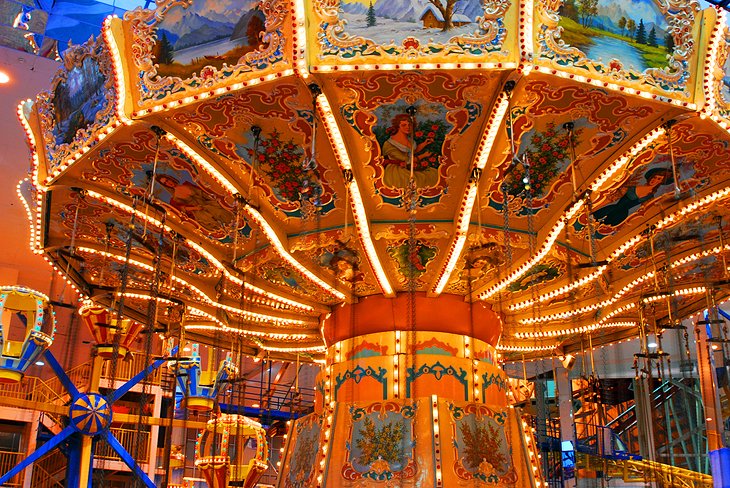
West Edmonton Mall is a shopping mall in Edmonton, Alberta, that is owned, managed, and operated by Triple Five Group. It is the second most visited mall in Canada, after the Toronto Eaton Centre in Toronto, followed by Metrotown Mall in Burnaby, and the 14th largest in the world by gross leasable area.
The West Edmonton Mall is more than just shops. Contained within this huge complex is the World Waterpark, the Ice Palace ice rink, mini golf, an aquarium with live shows, a bowling alley, a mirror maze, indoor electric go-kart racing, and movie theaters. Of course shopping is important, too. The mall has all kinds of stores for everything you could imagine.
The mall is a destination within Alberta, particularly in winter, where families can come to escape the cold and enjoy some indoor fun and shopping.
West Edmonton Mall covers a gross area of about 490,000 m2 (5,300,000 sq ft).It holds over 800 stores and services including nine attractions, two hotels and over 100 dining venues in the complex, and parking for more than 20,000 vehicles More than 24,000 people are employed at the property. The mall receives about 32 million visitors per year; it attracts between 90,000 and 200,000 shoppers daily, depending on the day and season.



